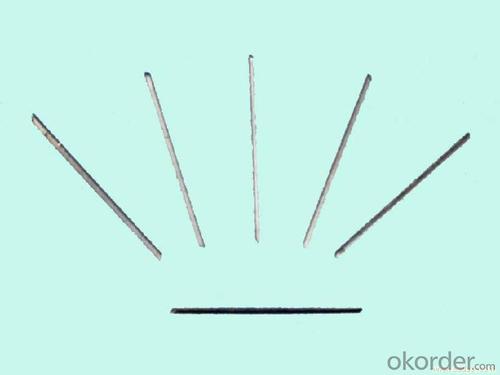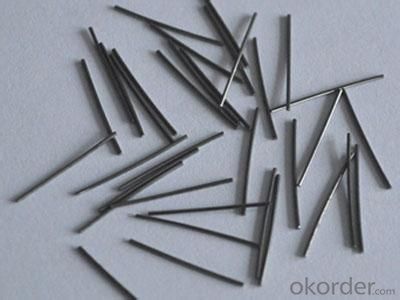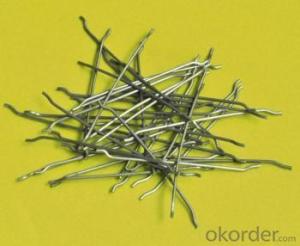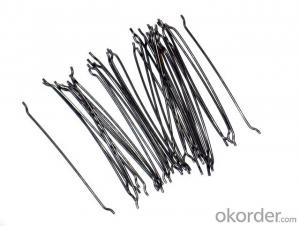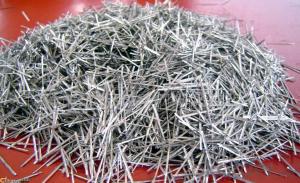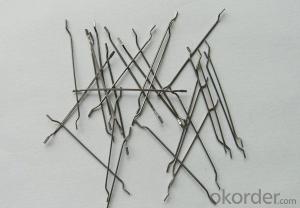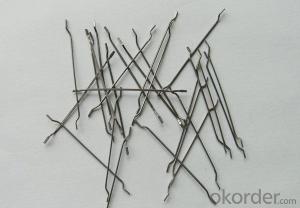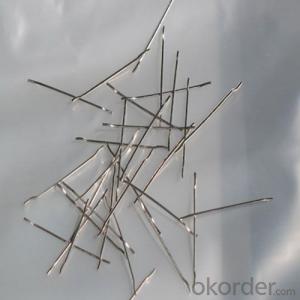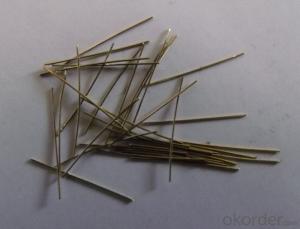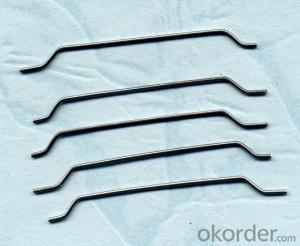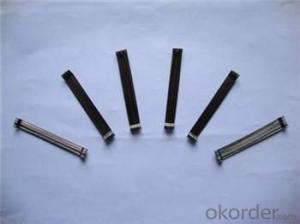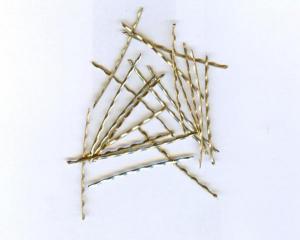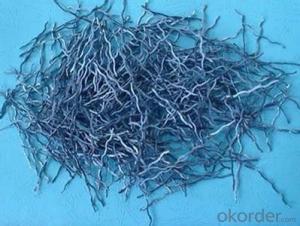Melt Extract Stainless Steel Fiber - Steel Fiber Straight Type CNBM China
- Loading Port:
- Tianjin
- Payment Terms:
- TT OR LC
- Min Order Qty:
- 1000 kg
- Supply Capability:
- 30000 kg/month
OKorder Service Pledge
OKorder Financial Service
You Might Also Like
Quick Details
Place of Origin: Jiangsu, China (Mainland)
Model Number: HT-ST
Material: Steel
Specifications
ISO 9001 certificated
2.70% for Europe, Middle Asia, America market
3.Have the most number of steel fiber machine in china
1. Material: low carbon steel wire or stainless steel
2.Diameter: 0.4mm-1.0mm
3.Length: meet your requirements
4.tensile strength >1000Mpa
6.Feature: excellent tensile,high tenacity,against cracking,impact and fatigue
7.Uses: highway road surface,tunnel,building,airport road surface and so on .
Straight Steel Fiber
1.ISO 9001 certificated
2.70% for Europe, Middle Asia, America market
3.Have the most number of steel fiber machine in china
Picture
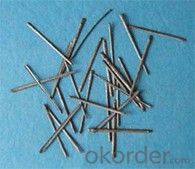
Steel fiber straight type
FAQ
certificated: ISO 9001
Technical advantages of Daye steel fiber:
A. Improve mechanical performance of concrete
B. Provide uniform distribution throughout concrete with excellent mixing
C. No balling or caking by adopt correct mixing method
D. Reduce concrete volume
E.Save construction time and cost
F.Reduce excavation volume
G.Available for jointless floor.
- Q: Can melt extract stainless steel fiber be used in high-rise building cladding?
- Yes, melt extract stainless steel fiber can be used in high-rise building cladding.
- Q: Can melt extract stainless steel fiber be used in seismic-resistant concrete structures?
- Yes, melt extract stainless steel fiber can be used in seismic-resistant concrete structures. Stainless steel fibers, including melt extract stainless steel fibers, are commonly used as reinforcement in concrete to enhance its tensile strength, ductility, and durability. In seismic-resistant concrete structures, where the concrete is subjected to significant dynamic loads during earthquakes, the inclusion of stainless steel fibers can significantly improve the overall performance and resistance of the structure. The use of melt extract stainless steel fibers in seismic-resistant concrete structures offers several advantages. Firstly, stainless steel fibers have high tensile strength and excellent ductility, which allows them to effectively distribute the applied forces and resist cracking and deformation under seismic loads. This helps to maintain the integrity of the concrete structure and prevent catastrophic failure during earthquakes. Additionally, stainless steel fibers exhibit excellent corrosion resistance, which is crucial in seismic-resistant concrete structures that may be exposed to harsh environmental conditions, such as high moisture or chloride exposure. The corrosion resistance of stainless steel fibers ensures the long-term durability and structural integrity of the concrete, even in aggressive environments. Moreover, melt extract stainless steel fibers also provide enhanced bond strength between the fiber and the concrete matrix. This improves the overall composite behavior of the concrete and enhances its resistance to shear stresses and cracking, which are common during seismic events. Overall, the use of melt extract stainless steel fiber in seismic-resistant concrete structures is a viable and effective solution to enhance their structural performance and durability. It helps to improve the tensile strength, ductility, and corrosion resistance of the concrete, ensuring its ability to withstand the dynamic forces and deformations associated with earthquakes.
- Q: What is the effect of melt extract stainless steel fiber on the modulus of creep of concrete?
- The effect of melt extract stainless steel fiber on the modulus of creep of concrete is that it generally improves the creep resistance of the concrete. The fibers act as reinforcement within the concrete matrix, reducing the likelihood of creep deformation over time. This leads to a higher modulus of creep, indicating that the concrete will experience less deformation under sustained loading conditions.
- Q: What are the advantages of using melt extract stainless steel fiber?
- There are several advantages of using melt extract stainless steel fiber in various applications. Firstly, melt extract stainless steel fiber offers exceptional strength and durability. The fibers are made from stainless steel, which is known for its high tensile strength and resistance to corrosion. This makes it suitable for use in demanding environments where other materials might fail. Secondly, the use of melt extract stainless steel fiber can greatly enhance the mechanical properties of a material. When added to concrete or other composites, the fibers act as reinforcement, improving its toughness, ductility, and resistance to cracking. This can result in longer-lasting and more resilient structures. Additionally, melt extract stainless steel fiber has excellent thermal properties. It has a high melting point, allowing it to withstand extreme temperatures without deforming or losing its structural integrity. This makes it an ideal choice for applications that involve high heat or fire hazards. Moreover, melt extract stainless steel fiber can provide electromagnetic shielding. Due to its conductive nature, it can effectively block electromagnetic waves, preventing interference and protecting sensitive electronic equipment. This makes it suitable for use in industries such as aerospace, telecommunications, and electronics. Furthermore, the use of melt extract stainless steel fiber can also lead to cost savings in the long run. By reinforcing materials and structures, it can increase their lifespan and reduce the need for frequent repairs or replacements. This can result in significant cost savings over time. In conclusion, the advantages of using melt extract stainless steel fiber are its exceptional strength and durability, improved mechanical properties, excellent thermal properties, electromagnetic shielding capabilities, and potential cost savings. These qualities make it a versatile and reliable choice for various applications in different industries.
- Q: Can melt extract stainless steel fiber be used in industrial flooring applications?
- Indeed, melt extract stainless steel fiber finds utility in the realm of industrial flooring applications. This particular fiber variety is renowned for its commendable robustness and endurance, attributes of utmost importance when it comes to flooring in industrial environments. Its capacity to endure substantial loads, impacts, and abrasions renders it apt for spaces that witness heavy pedestrian traffic or house machinery. Moreover, stainless steel fibers possess a resistance to corrosion and chemicals, guaranteeing a prolonged lifespan for the flooring material. Incorporating these fibers into concrete or alternative flooring substances is a simple task that elevates their potency and efficacy. All in all, melt extract stainless steel fiber emerges as a trustworthy option for industrial flooring applications.
- Q: What is the effect of melt extract stainless steel fiber on the permeability of concrete?
- The permeability of concrete is primarily decreased by the presence of melt extract stainless steel fiber. Once these fibers are incorporated into the concrete, they establish an interconnected network, thereby boosting its overall resilience and strength. The stainless steel fibers in concrete serve as a barrier against the movement of liquid, including water. This barrier effectively lowers the permeability of the concrete, rendering it less susceptible to water absorption, moisture infiltration, and subsequent harm caused by freezing and thawing or chemical attacks. Furthermore, the usage of melt extract stainless steel fibers in concrete helps diminish crack formation and shrinkage. These fibers reinforce the concrete and hinder crack propagation, thereby enhancing the structural integrity of the material as a whole. Consequently, this contributes to a reduction in permeability. Additionally, the stainless steel fibers also enhance the bond between the concrete and other materials, such as aggregates or reinforcement bars. This improved bond further decreases the permeability of the concrete by minimizing the potential for water to permeate through gaps or weak points in the structure. In conclusion, the inclusion of melt extract stainless steel fiber in concrete has a positive impact on its permeability. It lessens water absorption, diminishes crack formation, and improves the overall durability and strength of the material. Ultimately, this leads to improved performance and longevity of concrete structures.
- Q: How does melt extract stainless steel fiber affect the impact resistance of shotcrete?
- Shotcrete's impact resistance is greatly enhanced by melt extract stainless steel fiber. Shotcrete, which is typically used in construction and repair projects, is a high-strength concrete material that is sprayed onto surfaces. The inclusion of stainless steel fibers in shotcrete increases its tensile strength and toughness, rendering it highly resistant to impact and dynamic loads. Manufactured through a specialized process involving the melting of raw materials and their rapid extraction into thin, elongated fibers, melt extract stainless steel fibers are then incorporated into the shotcrete mix, ensuring even dispersion throughout the material. These fibers create a three-dimensional reinforcement network within the shotcrete, providing enhanced resistance to cracking and fragmentation when subjected to impact. The stainless steel fibers in shotcrete act as micro-reinforcements when confronted with impact forces, effectively absorbing and distributing the energy throughout the material. This prevents the formation and propagation of cracks, leading to improved impact resistance. The fibers also increase the shotcrete's ductility, allowing it to absorb more energy before failure. Furthermore, the corrosion resistance of stainless steel fibers ensures the long-term durability and performance of the shotcrete. These fibers do not rust or deteriorate over time, even in harsh environmental conditions, further enhancing the overall impact resistance of shotcrete. In conclusion, the addition of melt extract stainless steel fiber significantly enhances shotcrete's impact resistance. The fibers reinforce the material, prevent crack formation, and improve its toughness and ductility. Consequently, shotcrete with stainless steel fibers is an excellent choice for applications where impact resistance is of paramount importance, such as tunnel linings, retaining walls, and protective barriers.
- Q: The steel fiber concrete cover per cubic concrete how much steel fiber
- The design is specified, usually according to the total amount of cementitious material
- Q: How does melt extract stainless steel fiber affect the shrinkage of concrete?
- The shrinkage of concrete can be significantly impacted by melt extract stainless steel fiber. When incorporated into concrete mixtures, these fibers aid in minimizing the overall shrinkage of the material. This is attributed to the distinct properties of stainless steel fibers, such as their remarkable tensile strength and minimal thermal expansion coefficient. During the process of curing, concrete undergoes a chemical reaction known as hydration, in which water reacts with cement to form a solid matrix. As this reaction occurs, the water evaporates, resulting in the shrinkage of the concrete. This shrinkage can potentially cause cracks and reduce the durability of the concrete structure. Nevertheless, the inclusion of melt extract stainless steel fibers assists in alleviating this issue by providing reinforcement within the concrete matrix. These fibers function as reinforcement bars, evenly dispersing the stresses generated by shrinkage throughout the concrete. Consequently, the overall shrinkage and subsequent cracking are diminished. Additionally, the low thermal expansion coefficient of stainless steel fibers aids in minimizing the impact of temperature fluctuations on the concrete. Variations in temperature can cause concrete to expand and contract, leading to further shrinkage and potential cracking. The stainless steel fibers help to limit these movements, thereby preserving the integrity of the concrete structure. To summarize, melt extract stainless steel fibers have a positive influence on concrete shrinkage by reducing overall shrinkage and mitigating the possibility of cracking. Their superior tensile strength and minimal thermal expansion coefficient make them an effective reinforcement material, enhancing the longevity and durability of concrete structures.
- Q: Can melt extract stainless steel fiber be used in swimming pool structures?
- Yes, melt extract stainless steel fiber can be used in swimming pool structures. Its corrosion resistance and durability make it suitable for use in water environments.
Send your message to us
Melt Extract Stainless Steel Fiber - Steel Fiber Straight Type CNBM China
- Loading Port:
- Tianjin
- Payment Terms:
- TT OR LC
- Min Order Qty:
- 1000 kg
- Supply Capability:
- 30000 kg/month
OKorder Service Pledge
OKorder Financial Service
Similar products
Hot products
Hot Searches
Related keywords


